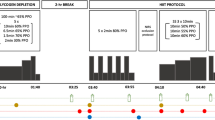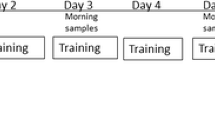Summary
Rapid depletion of muscle glycogen occurs during activities greater than 100% of maximal oxygen uptake. While carbohydrate ingestion prior to an endurance event has been shown to be beneficial, the effects of carbohyrate ingestion on repeated bouts of high-intensity exercise are not known. Therefore, the purpose of this study was to determine if carbohydrate ingestion prior to repeated bouts of high-intensity, short-duration exercise would improve performance. Ten well-trained male cyclists performed two experimental rides, one 15 min after consumption of 5.0 ml·kg−1 body weight of a 19.7% carbohydrate drink and one following a placebo. The experimental ride consisted of four 1.6 km timed performance rides separated by 4.8 km steadystate rides at 80% of maximal oxygen uptake (between the last two performance rides the steady-state rides were 1.6 km at 80% and 1.6 km at 90%). Blood glucose levels were significantly increased following both the ingestion of the carbohydrate beverage and the performance of the exercise bout. Total exercise time following ingestion of the experimental drink [mean (SD); 25.6 (3.3) min] was not different from that following ingestion of the placebo [25.2 (3.3) min]. Similarly, the sum of all four timed performance rides following ingestion of the experimental drink [6.8 (0.9) min] was not different from that following ingestion of the placebo [6.6 (0.9) min]. In the present study, carbohydrate ingestion 15 min prior to exercise increased blood glucose levels, although performance time was not affected.
Similar content being viewed by others
References
Borg G, Ljunggren G, Ceci R (1985) The increase of perceived exertion, aches and pain in the legs, heart rate and blood lactate during exercise on a bicycle ergometer. Eur J Appl Physiol 54:343–349
Costill DL, Sherman WM, Fink WJ, Maresh C, Witten M, Miller JM (1981) The role of dietary carbohydrates in muscle glycogen resynthesis after strenuous running. Am J Clin Nutr 34:1831–1836
Coyle EF, Coggan AR (1984) Effectiveness of carbohydrate feeding in delaying fatigue during prolonged exercise. Am J Clin Nutr. 34:1831–1836.
Coyle EF, Coggan AR, Hemmert MK, Lowe RC, Walters TJ (1985) Substrate usage during prolonged exercise following a preexercise meal. J Appl Physiol 59:429–433
Essen B (1978) Studies on the regulation of metabolism in human skeletal muscle using intermittent exercise as an experimental model. Acta Physiol Scand [Suppl 454]:1–32
Fielding RA, Costill DL, Fink WJ, King DS, Hargreaves M, Kovaleski JE (1985) Effect of carbohydrate feeding frequencies and dosage on muscle glycogen use during exercise. Med Sci Sports Exerc 17:472–476
Gleeson M, Maughan RJ, Greenhaff PL (1986) Comparison of the effects of pre-exercise feeding of glucose, glycerol and placebo on endurance and fuel homeostasis in man. Eur J Appl Physiol 55:645–653
Gollnick PD, Piehl K, Saltin B (1974) Selective glycogen depletion pattern in human muscle fibres after exercise of varying intensity and at varying pedalling rates. J Physiol (Lond) 241:45–57
Hargreaves M, Costill DL, Coggan A, Fink WJ, Nishibata I (1984) Effect of carbohydrate feedings on muscle glycogen utilization and exercise performance. Med Sci Sports Exerc 16:219–222
Hutber CA, Bonen A (1989) Glycogenesis in muscle and liver during exercise. J Appl Physiol 66:2811–2817
Ivy JL, Katz AL, Cutler CL, Sherman WM, Coyle EF (1988) Muscle glycogen synthesis after exercise: effect of time of carbohydrate ingestion. J Appl Physiol 64:1480–1485
Jackson AS, Pollock ML (1978) Generalized equations for predicting body density of man, Br J Nutr 49:497–504
Kuipers H, Keizer HA, Brouns F, Saris WHM (1987) Carbohydrate feeding and glycogen synthesis during exercise in man. Pflügers Arch 410:652–656
Legar L, Thivierge M (1988) Heart rate monitors: validity, stability and functionality.Physician Sportsmed 16:143–151
Maughan RJ, Poole DC (1981) The effects of a glycogen — loading regimen on the capacity to perform anaerobic exercise. Eur J Appl. Physiol 46:211–219
Maughan RJ, Leiper JB, McGaw BA (1990) Effects of exercise intensity on absorption of ingested fluids in man. Exp Physiol 75:419–421
Neufer PD, Costill DL, Flynn MG, Kirwan JP, Mitchell JB, Houmard J (1987) Improvements in exercise performance: effects of carbohydrate feedings and diet. J Appl Physiol 62:983–988
Rehrer NJ, Beckers E, Brouns F, Hoor F ten, Saris WHM (1989) Exercise and training effects on gastric emptying of carbohydrate beverages. Med Sci Sports Exerc 21:540–549
Seifert JG (1991) The comparison of physiological responses from cycling on friction-braked and electromagnetic ergometers. Res Q Exerc Sport 62:115–117
Author information
Authors and Affiliations
Rights and permissions
About this article
Cite this article
Snyder, A.C., Moorhead, K., Luedtke, J. et al. Carbohydrate consumption prior to repeated bouts of high-intensity exercise. Europ. J. Appl. Physiol. 66, 141–145 (1993). https://doi.org/10.1007/BF01427055
Accepted:
Issue Date:
DOI: https://doi.org/10.1007/BF01427055




